Spatial Configuration of Energy Consumption and Carbon Emissions of Shanghai, and Our Policy Suggestions
Abstract
:1. Introduction
2. Materials and Methods
2.1. Estimation Method for Energy Related CO2 Emissions
2.2. Method of Gridding of Energy Consumption and Carbon Emissions Data
2.2.1. Point Emission Sources
2.2.2. Line Sources
2.2.3. Area Sources
3. Spatial Configuration Characteristics and Trends Analysis
3.1. Coal
3.1.1. Main Characteristics and Coping Strategy
3.1.2. Trends of Shanghai Coal Consumption
3.2. Oil
3.2.1. Main Characteristics of Spatial Configuration
3.2.2. Trends of Shanghai Oil Consumption
3.3. Natural Gas
3.3.1. Main Characteristics of Spatial Configuration
3.3.2. Trends of Shanghai Natural Gas Consumption
3.4. Spatial Distribution of Shanghai Total Energy Consumption and Carbon Emission
3.4.1. Main Characteristics of Spatial Configuration
3.4.2. Trends of Shanghai Energy Consumption
3.4.3. Trends of Shanghai Energy-Related CO2 Emissions
4. Conclusions and Policy Suggestions
Acknowledgments
Author Contributions
Conflicts of Interest
References
- CDIAC. Global Carbon Budget 2016. Available online: http://cdiac.ornl.gov/GCP/ (accessed on 20 November 2016).
- Collins, M.; Knutti, R. Long-term climate change: Projections, commitments and irreversibility. In Climate Change 2013: The Physical Science Basis; Contribution of Working Group I to the Fifth Assessment Report of the Intergovernmental Panel on Climate Change; Stocker, T., Qin, D., Plattner, G., Eds.; Cambridge University Press: Cambridge, UK, 2014; pp. 1029–1136. [Google Scholar]
- United Nations, Department of Economic and Social Affairs, Population Division (2014). World Urbanization Prospects: The 2014 Revision, Highlights (ST/ESA/SER.A/352); United Nations Publications: New York, NY, USA, 2014; Available online: http://www.indiaenvironmentportal.org.in/files/file/urbanization%202014.pdf (accessed on 5 November 2016).
- Seto, K.C.; Guneralp, B.; Hutyra, L.R. Global forecasts of urban expansion to 2030 and direct impacts on biodiversity and carbon pools. Proc. Natl. Acad. Sci. USA 2012, 109, 16083–16088. [Google Scholar] [CrossRef] [PubMed]
- Patarasuk, R.; Gurney, K.R.; O’Keeffe, D.; Song, Y.; Huang, J.; Rao, P.; Buchert, M.; Lin, J.C.; Mendoza, D.; Ehleringer, J.R. Urban high-resolution fossil fuel CO2 emissions quantification and exploration of emission drivers for potential policy applications. Urban Ecosyst. 2016, 19, 1013–1039. [Google Scholar] [CrossRef]
- Kort, E.A.; Frankenberg, C.; Miller, C.E.; Oda, T. Space-based observations of megacity carbon dioxide. Geophys. Res. Lett. 2012, 39, 26–33. [Google Scholar] [CrossRef]
- Gurney, K.R.; Razlivanov, I.; Song, Y.; Zhou, Y.; Benes, B.; Abdul-Massih, M. Quantification of fossil fuel CO2 emissions on the building/street scale for a large U.S. city. Environ. Sci. Technol. 2012, 46, 12194–12202. [Google Scholar] [CrossRef] [PubMed]
- Grimm, N.B.; Faeth, S.H.; Golubiewski, N.E.; Redman, C.L.; Wu, J.; Bai, X.; Briggs, J.M. Global change and the ecology of cities. Science 2008, 319, 756–760. [Google Scholar] [CrossRef] [PubMed]
- C40 Cities. Available online: http://www.c40.org/about (accessed on 15 November 2016).
- Gurney, K.R. Recent research quantifying anthropogenic CO2 emissions at the street scale within urban domain. Carbon Manag. 2014, 5, 309–320. [Google Scholar] [CrossRef]
- The Hestia Project. Available online: http://hestia.project.asu.edu/index.shtml (accessed on 15 November 2016).
- Feng, S.; Lauvaux, T.; Newman, S.; Rao, P.; Ahmadov, R.; Deng, A.; Díaz-Isaac, L.I.; Duren, R.M.; Fischer, M.L.; Gerbig, C.; et al. Los Angeles megacity: A high-resolution land–atmosphere modelling system for urban CO2 emissions. Atmos. Chem. Phys. 2016, 16, 9019–9045. [Google Scholar] [CrossRef]
- Bréon, F.M.; Broquet, G.; Puygrenier, V.; Chevallier, F.; Xueref-Remy, I.; Ramonet, M.; Dieudonné, E.; Lopez, M.; Schmidt, M.; Perrussel, O.; et al. An attempt at estimating Paris area CO2 emissions from atmospheric concentration measurements. Atmos. Chem. Phys. 2015, 15, 1707–1724. [Google Scholar] [CrossRef]
- Liu, Z.; Geng, Y.; Xue, B. Inventorying energy-related CO2 for city: Shanghai study. Energy Procedia 2011, 5, 2303–2307. [Google Scholar] [CrossRef]
- Wang, H.; Zhang, R.; Liu, M.; Bi, J. The carbon emissions of Chinese cities. Atmos. Chem. Phys. 2012, 12, 6197–6206. [Google Scholar] [CrossRef]
- Dajian, C.W.Z. Decomposition of energy-related CO2 emissions from Shanghai’s industries and policy implications. China Popul. Resour. Environ. 2012, 10, 40–46. [Google Scholar]
- Cai, B.; Zhang, L. Study on the spatial characteristics of urban CO2 emissions in Shanghai. Adv. Clim. Chang. Res. 2014, 6, 417–426. (In Chinese) [Google Scholar]
- Sinton, J.E. Accuracy and reliability of China’s energy statistics. China Econ. Rev. 2001, 12, 373–383. [Google Scholar] [CrossRef]
- Zhao, Y.; Nielsen, C.P.; McElroy, M.B.; Zhang, L.; Zhang, J. CO emissions in China: Uncertainties and implications of improved energy efficiency and emission control. Atmos. Environ. 2012, 49, 103–113. [Google Scholar] [CrossRef]
- Teng, F.; Zhu, S. Which estimation is more accurate? Technical comments on Nature Paper by Liu et al on overestimation of China’s emission. Sci. Technol. Rev. 2015, 22, 112–116. (In Chinese) [Google Scholar]
- Liu, Z.; Guan, D.; Wei, W.; Davis, S.J.; Ciais, P.; Bai, J.; Peng, S.; Zhang, Q.; Hubacek, K.; Marland, G.; et al. Reduced carbon emission estimates from fossil fuel combustion and cement production in China. Nature 2015, 524, 335–338. [Google Scholar] [CrossRef] [PubMed]
- Hong, C.; Zhang, Q.; He, K.; Guan, D.; Li, M.; Liu, F.; Zheng, B. Variations of China’s emission estimates response to uncertainties in energy statistics. Atmos. Chem. Phys. Discuss. 2016. [Google Scholar] [CrossRef]
- Shanghai Master Plan (2016–2040). Available online: http://www.supdri.com/2040/public/images/gongshi/3.pdf (accessed on 15 November 2016).
- Wei, W.; Ren, X.; Cai, Z.; Hou, Q.; Liu, Y.; Li, Q. Research on China’s Greenhouse gas emission—Progress on emission inventory from the CAS strategic priority research program. Bull. Chin. Acad. Sci. 2015, 6, 839–847. (In Chinese) [Google Scholar]
- Shanghai Statistical Bureau. Shanghai Statistical Yearbook on Energy, 2011; Shanghai Press: Shanghai, China, 2011. (In Chinese)
- IPCC (Intergovernmental Panel on Climate Change). IPCC Guidelines for National Greenhouse Gas Inventories; United Kingdom Meteorological Office: Bracknell, UK, 2006.
- Fudan University Energy Flow and Potential Carbon Emission Factor Database. Available online: http://dvn.fudan.edu.cn/dvn/dv/FDED (accessed on 10 November 2016).
- Pan, K.; Zhu, H.; Chang, Z.; Wu, K.; Shan, Y.; Liu, Z. Estimation of coal-related CO2 emissions: The case of China. Energy Environ. 2013, 24, 1309–1321. [Google Scholar]
- Shanghai City Comprehensive Transportation Planning Institute. Annual report on Shanghai comprehensive transportation (2011). Traffic Transp. 2011, 27, 11–13. (In Chinese) [Google Scholar]
- Shanghai Statistical Bureau. Shanghai Regional Annual Statistical Bulletin 2011. Available online: http://www.stats-sh.gov.cn/tohtml/toWorkContact.xhtml (accessed on 2 November 2016). (In Chinese)
- National Bureau of Statistics of China. Tabulation on the 2010 Population Census of the People’s Republic of China. Available online: http://www.stats.gov.cn/english/Statisticaldata/CensusData/rkpc2010/indexch.htm (accessed on 8 October 2016).
- Zhu, H.; Pan, K.; Liu, Z. Coal flow diagrams and its total consumption control line for Shanghai. Power Energy 2014, 3, 237–242. (In Chinese) [Google Scholar]
- Shanghai Government. Shanghai 13th Five Year Plan of Comprehensive Transportation. Available online: http://wap.sh.gov.cn/nw2/nw2314/nw2319/nw12344/u26aw50326.html (accessed on 12 November 2016).
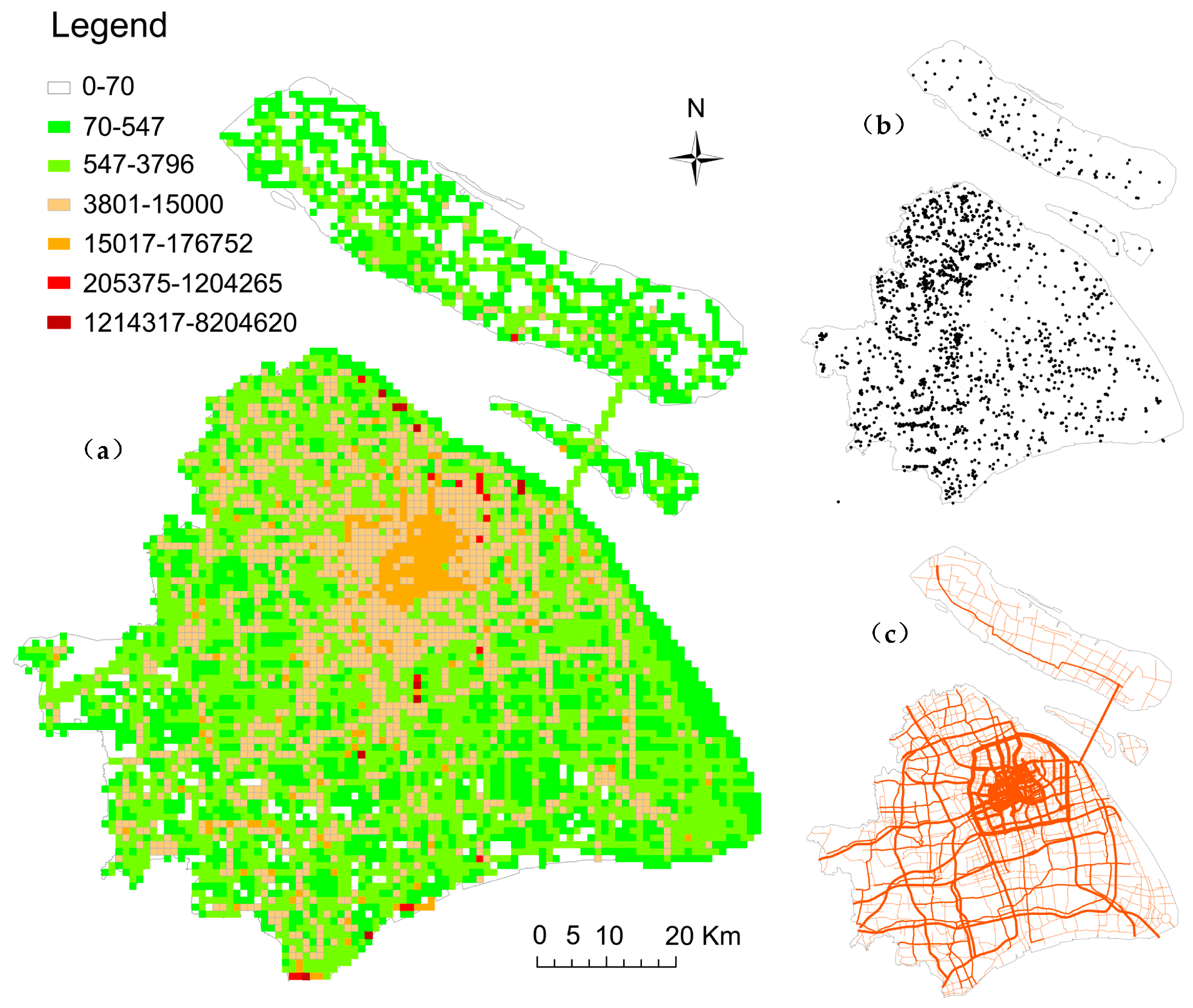
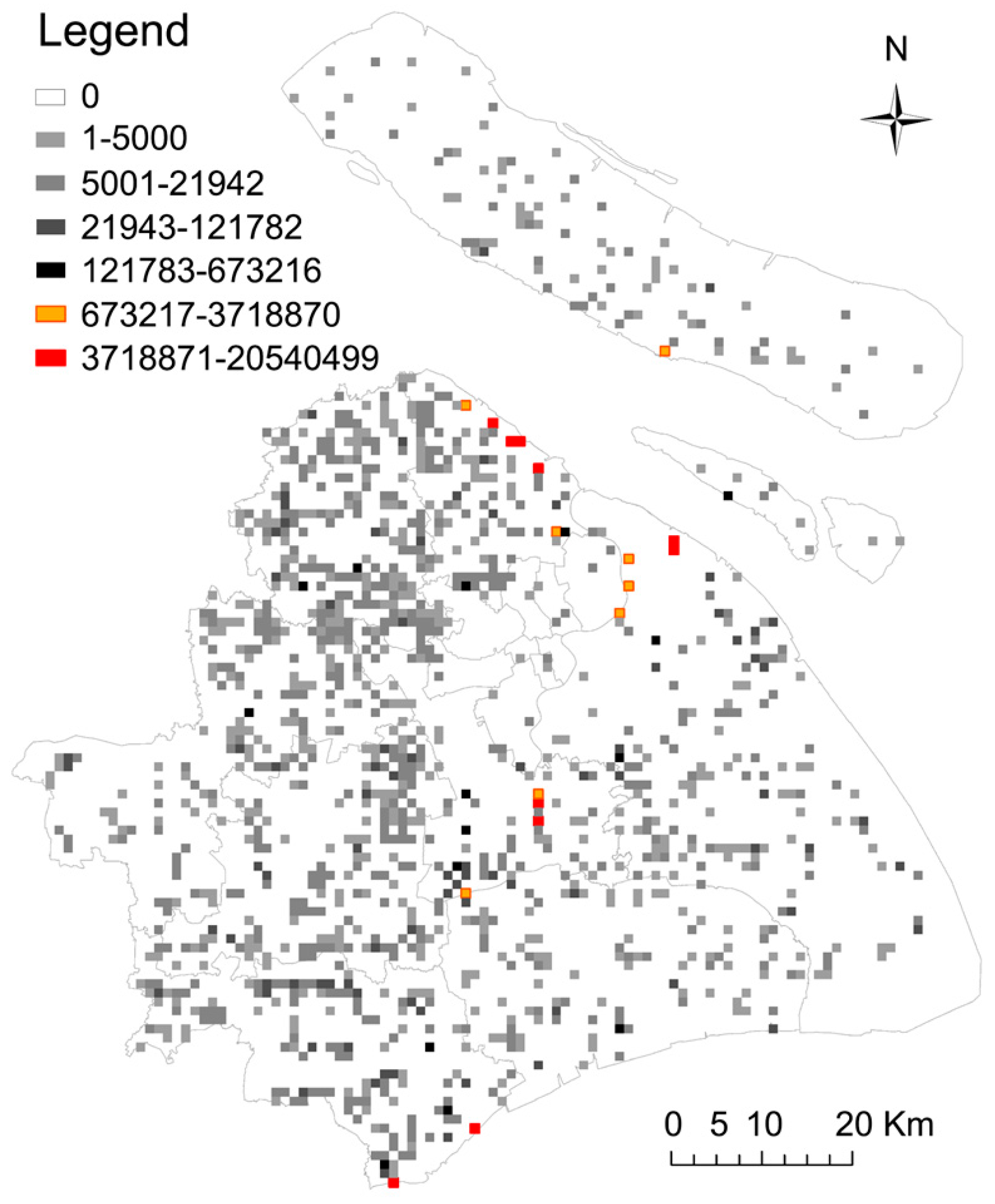
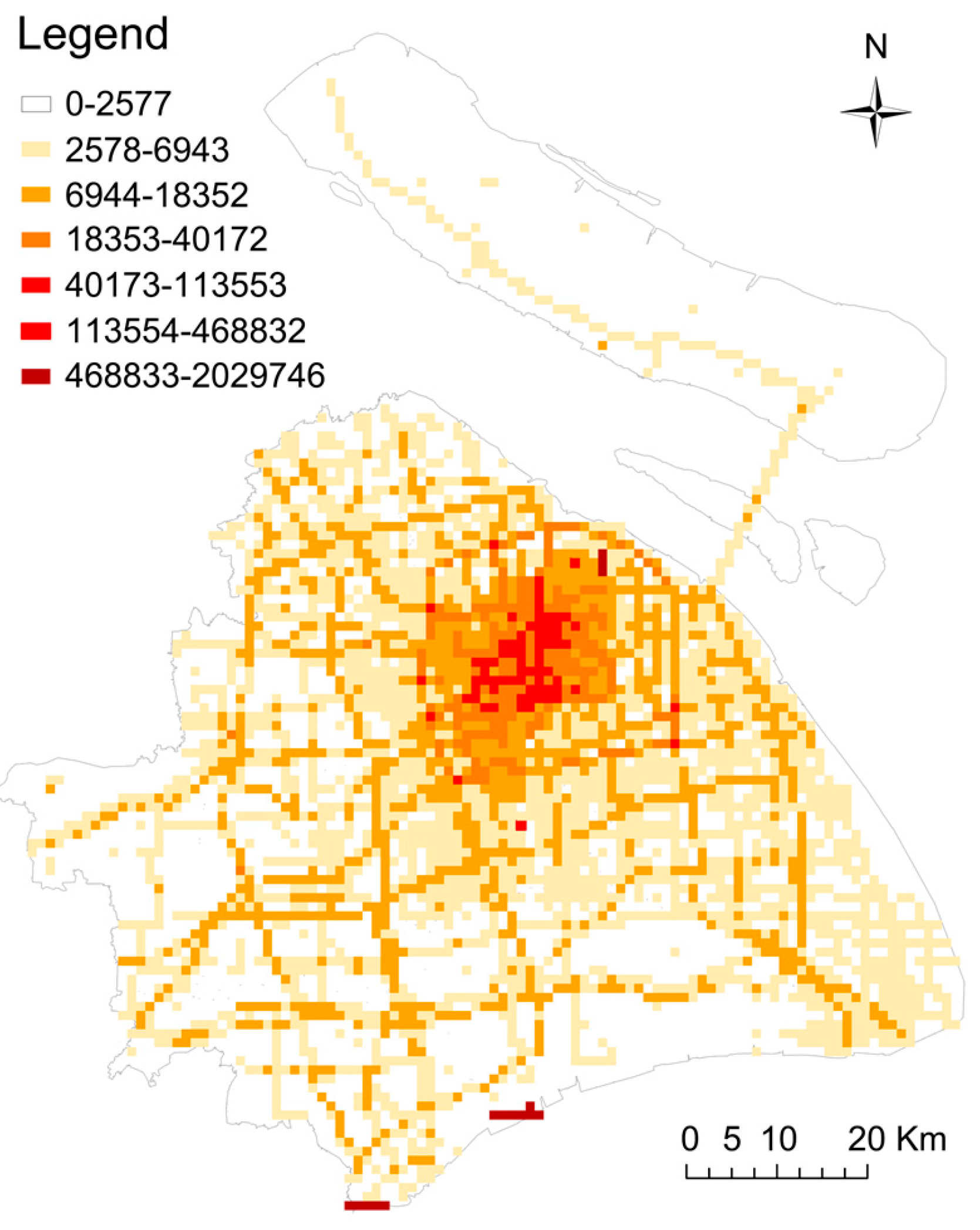
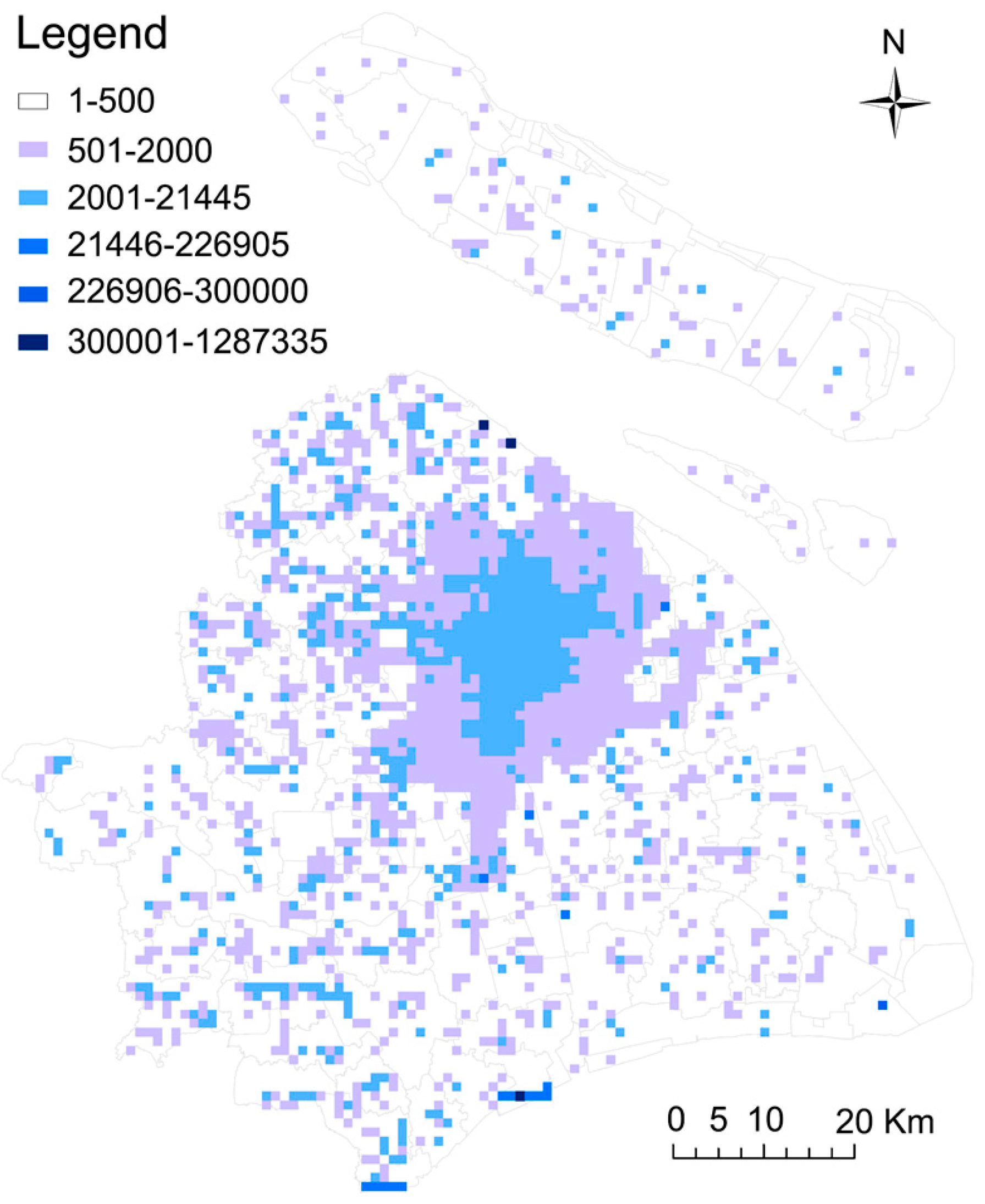
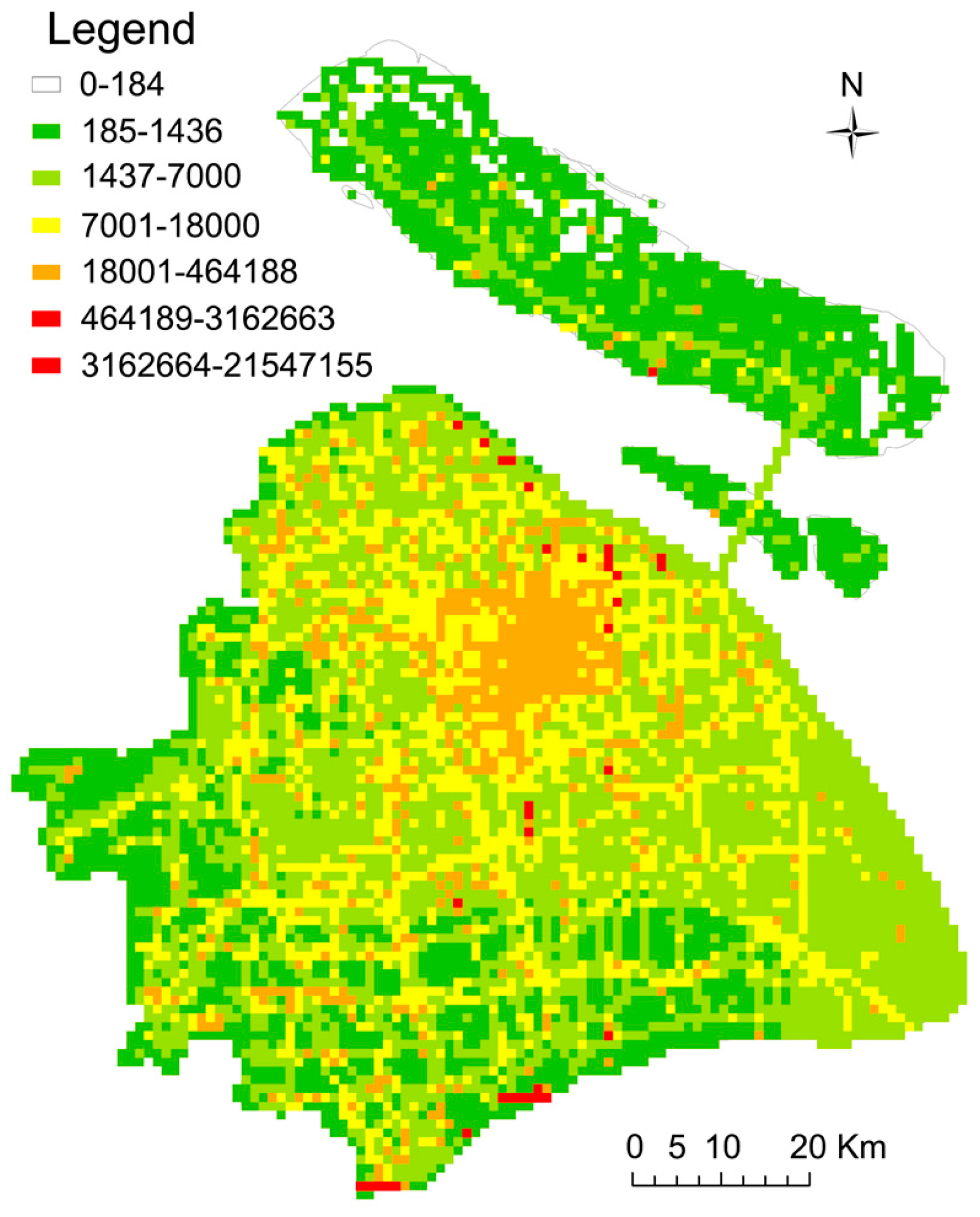
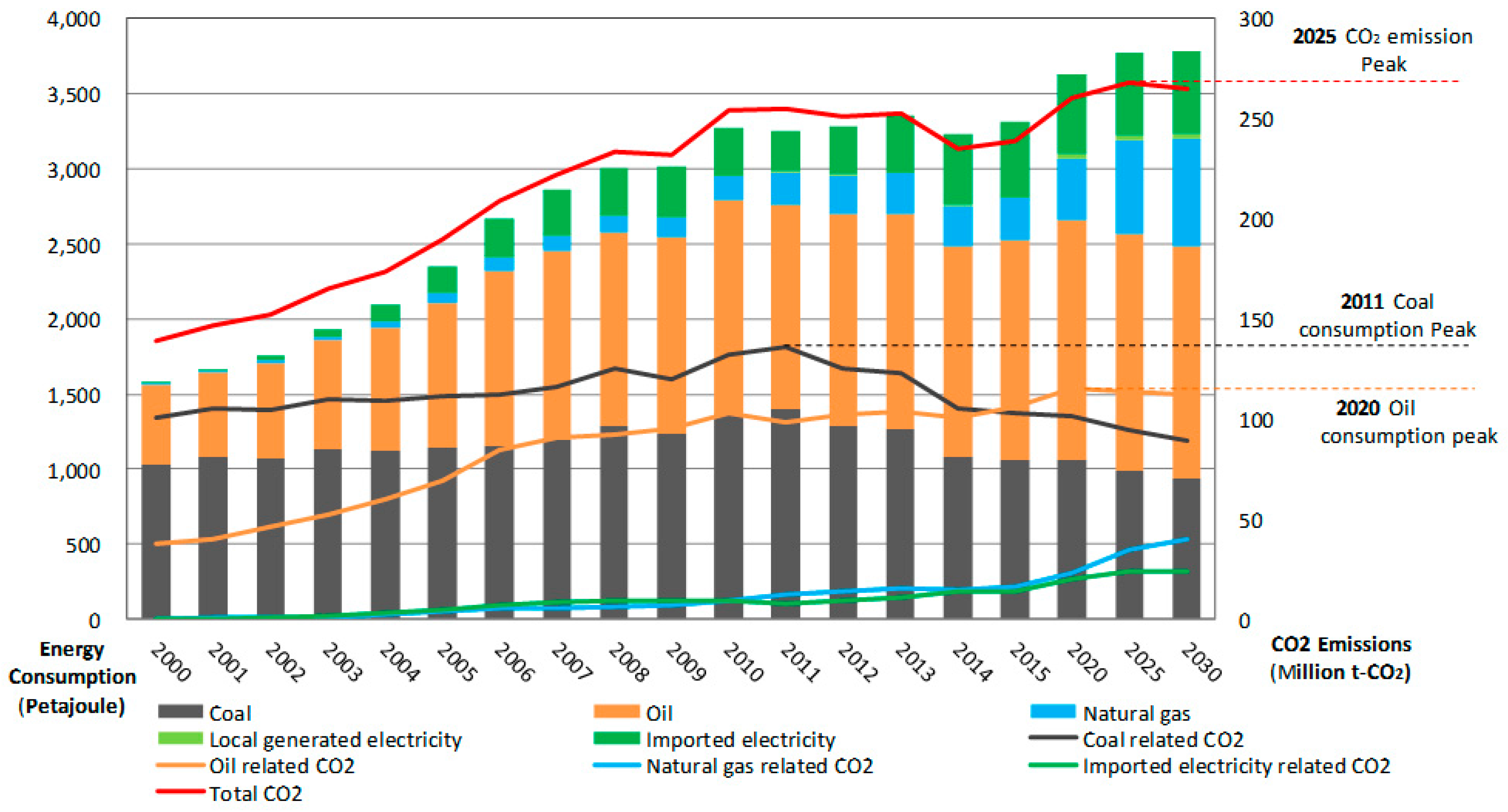
| Fuel Types | Net Heat Values MJ/kg, MJ/m3 | Emission Factors kg-C/MJ | |
|---|---|---|---|
| Coal | Coal for electricity | 21.41 | 26.78 |
| Coal for heating | 20.54 | 26.78 | |
| Coking coal | 27.71 | 25.21 | |
| PCI | 26.14 | 27.39 | |
| Lump coal | 25.68 | 26.86 | |
| Feed coal | 24.89 | 26.29 | |
| Steam coal used in other industries | 21.74 | 26.29 | |
| Coke | 28.43 | 29.20 | |
| Oil | Gasoline | 43.07 | 18.92 |
| Diesel | 43.51 | 20.22 | |
| Kerosene | 43.07 | 19.12 | |
| Fuel oil | 41.82 | 21.12 | |
| LPG | 50.18 | 17.22 | |
| Refinery gas | 46.00 | 15.72 | |
| Other oil products | 35.43 | 20.02 | |
| Natural gas | Natural gas used by power plants | 34.71 | 15.32 |
| Natural gas used by other sectors | 36.30 | 15.32 | |
| Road Types | City Centre | Suburb | |||
|---|---|---|---|---|---|
| Pxii | Pdii | Pxio | Pdio | Aoo | |
| Fast road | 32.3% | 27.9% | 49.3% | 49.7% | 34.8% |
| Primary road | 36.1% | 39.7% | 26.1% | 23.5% | 35.4% |
| Secondary road | 17.0% | 21.7% | 11.4% | 13.2% | 17.5% |
| Local road | 14.6% | 10.7% | 13.1% | 13.7% | 12.2% |
| Sum | 100.0% | 100.0% | 100.0% | 100.0% | 100.0% |
| Fuel Types | Sectors | Proxy |
|---|---|---|
| Coal | middle & small coal fired boilers | Industry concentration |
| Oil | industrial enterprises below designated size | Industry concentration |
| commercial sector | GDP of tertiary industry | |
| Resident sector | Population | |
| Agriculture | GDP of agriculture | |
| Natural gas | industrial enterprises below designated size | Industry concentration |
| commercial sector | GDP of tertiary industry | |
| Resident sector | population |
| Year | Total | Power Generation | Heating | Middle and Small Sized Boilers | Gas | Coking | PCI | Chemical Feed | Used by Corex |
|---|---|---|---|---|---|---|---|---|---|
| 2010 | 58.76 | 34.21 | 32.25 | 5.34 | 0.08 | 9.75 | 3.76 | 1.44 | 0.95 |
| 2011 | 61.42 | 36.68 | 32.40 | 5.07 | 0.07 | 9.92 | 3.62 | 1.37 | 1.45 |
| 2012 | 57.03 | 33.97 | 32.26 | 4.25 | 0.09 | 9.87 | 3.40 | 1.58 | 0.64 |
| 2013 | 56.86 | 35.59 | 31.02 | 4.55 | 0.04 | 8.38 | 3.48 | 1.72 | 0.0 |
| 2014 | 48.96 | 28.14 | 29.95 | 4.55 | 0.01 | 7.59 | 3.59 | 2.07 | 0.0 |
| 2015 | 47.28 | 27.45 | 29.57 | 3.03 | 0.0 | 8.31 | 3.48 | 2.05 | 0.0 |
| Road Types | City Centre | Suburb | |||
|---|---|---|---|---|---|
| Pxii | Pdii | Pxii | Pdii | Pxii | |
| Fast road | 8.210 | 5.865 | 8.067 | 6.899 | 1.899 |
| Primary road | 6.993 | 4.181 | 3.402 | 1.683 | 1.415 |
| Secondary road | 1.823 | 1.588 | 0.681 | 0.656 | 0.282 |
| Local road | 0.181 | 0.115 | 0.136 | 0.110 | 0.048 |
| Average | 1.105 | 0.917 | 0.827 | 0.631 | 0.265 |
| Fuel Types | Top-Down Approach | Bottom-Up Approach | Differences | Percentage |
|---|---|---|---|---|
| Coal | 13,066.1 | 13,066.1 | 0.0 | |
| Coke | 259.7 | 259.7 | 0.0 | |
| Oil | 9633.1 | 6162.5 | 3470.6 | 14.1% |
| Natural gas | 909.4 | 909.4 | 0.0 | |
| Imported electricity | 736.4 | 0.0 | 736.4 | 3.0% |
| Sum | 24,604.8 | 20,397.7 | 4207.1 | 17.1% |
© 2017 by the authors; licensee MDPI, Basel, Switzerland. This article is an open access article distributed under the terms and conditions of the Creative Commons Attribution (CC-BY) license (http://creativecommons.org/licenses/by/4.0/).
Share and Cite
Pan, K.; Li, Y.; Zhu, H.; Dang, A. Spatial Configuration of Energy Consumption and Carbon Emissions of Shanghai, and Our Policy Suggestions. Sustainability 2017, 9, 104. https://doi.org/10.3390/su9010104
Pan K, Li Y, Zhu H, Dang A. Spatial Configuration of Energy Consumption and Carbon Emissions of Shanghai, and Our Policy Suggestions. Sustainability. 2017; 9(1):104. https://doi.org/10.3390/su9010104
Chicago/Turabian StylePan, Kexi, Yongfu Li, Hanxiong Zhu, and Anrong Dang. 2017. "Spatial Configuration of Energy Consumption and Carbon Emissions of Shanghai, and Our Policy Suggestions" Sustainability 9, no. 1: 104. https://doi.org/10.3390/su9010104
APA StylePan, K., Li, Y., Zhu, H., & Dang, A. (2017). Spatial Configuration of Energy Consumption and Carbon Emissions of Shanghai, and Our Policy Suggestions. Sustainability, 9(1), 104. https://doi.org/10.3390/su9010104





